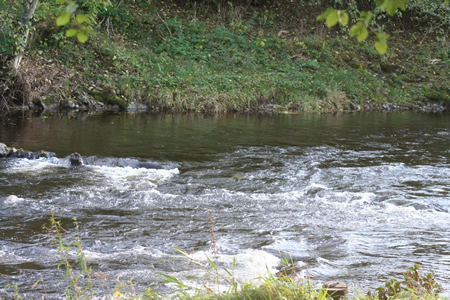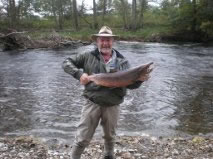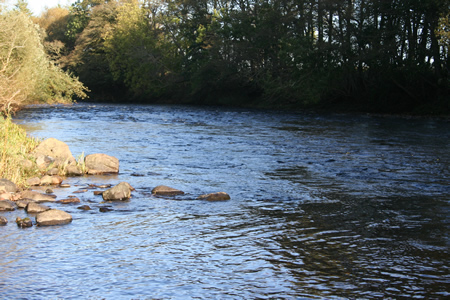These bulletin blogs represent news about Finavon and the South Esk, and my views as a riparian owner. They are not the views of any other organisation, nor are they designed to promote the interests of any individual or organisation other than Finavon Castle Water and factors affecting the fishery. Tony Andrews
October hasn’t come up to its usual billing, with only 4 salmon and a couple of sea trout for the month so far. It is worth remembering that October is normally Finavon’s most productive month for salmon, but this year, after an unusually wet summer, the river is low, the temperatures are still high and few fresh salmon are entering the River. If we get some water (there were a few inches overnight) and some colder nights (the forecast is that they are on the way) the fishing should improve for the last two weeks of this season. Adam Carr and his party took all four beats for the week just gone. They saw plenty of fish, some very big ones amongst them and they lost a few, but generally the fishing was slow. Simon Cordukes, one of Adam’s party, caught and returned a red cock fish of about 16lbs from the head of Indies Pool on Saturday 15/10 (See photo below).
The River is in fine fettle with clean gravels and a good flow of clear water, if a bit on the low side for the time of year. A few recently spawned sea trout kelts are in evidence, but very few diseased salmon and every indication that this year will have a productive spawning season. Much will depend on river and weather conditions after eggs have been deposited and fertilised.
This is the head of Pheasantry close to the Castle Beat Treehouse fishing hut. During the 2011 season there have been salmon, sea trout and grilse regularly seen, and some caught, in this pool.
The Government decides on the level of netting.
In the last week we have heard that the Fisheries Minister, Stewart Stevenson, has decided to allow the coastal nets in the Esk District to continue fishing in the month of May and that they will also be permitted to fish during the first fifteen days of September on a trial basis for three years. Access by scientists to the catches in the Usan mixed stocks nets has been granted by George Pullar in return for the two September weeks. Under the current voluntary arrangement we can assume that the nets will not fish during the period 16 February to 30 April and that, provided reasonable compensation is offered, the nets will continue to release all sea trout alive, and any that are killed accidentally will not be sold.
Looking at the Minister’s decision objectively, bearing in mind that Usan nets have the same heritable right to catch salmon and sea trout as anglers do, it seems to me that he has taken a logical and progressive step forward in modernising the management of the South Esk fishery. Let me explain what I mean:
1. How many salmon do we have?
My main concern for some time has been that no-one has any idea of what South Esk stocks of salmon and sea trout comprise. We may assume that the river has a number of distinct genetic groups (‘populations’ in scientific parlance), but at present we don’t know what these groups are, nor how many spawners there are in each population to meet conservation levels, and of course we have absolutely no idea how many of each population are exploited by the mixed stocks nets, which take salmon from neighbouring rivers, as well as from the South Esk. While I have tried recently to estimate (see the bulletin of 14 June) what the overall stock number is, and made an attempt to break these figures down into groups of fish distinguished from each other by run timing, my calculations are based on amateur observation, a bit of mathematics and a huge amount of guessing. We need facts, and only science can provide us with the measurements and methodology needed to determine the size and breakdown of the South Esk stock . That is why we need the full engagement of government scientists who, with our help, can put in place the process for assessing the South Esk Stocks.
2. How can we help?
Counting them in and counting them out. I think we need to persuade the Esk District Fishery Board to investigate how inward and outward migrations of the South Esk can best be measured. New technologies for counting fish are being developed all the time, costs are coming down, and the days of having to build a huge concrete structure spanning the full width of the main stem of the river (as at Logie on the North Esk) are of the past. We need to talk to our friends in Norway, Canada, Ireland and Iceland, as well as with our own fisheries experts, to identify the method that offers the best value for money. The Board has substantial reserves, some of which could be allocated to a fund to purchase, maintain and manage a fish counting system for the South Esk. We should be working with the Montrose scientists, taking their advice on the location of measuring sites, and feeding the data to them for analysis and integrating with the genetic data coming from sampling the net catches. With cooperation and by working together (netsmen, riparian owners, fishery managers, government scientists and the Esk Fisheries and Rivers Trust) we should be able to build a picture of the South Esk stocks quite quickly. It is not unreasonable to suggest that the picture could quite soon become very much clearer than it is today.
The lower section of this smallish pool is where running salmon and sea trout sometimes stop in a spate. The whole of Pheasantry is a very nice stream running over a boulder and gravel bottom with a maximum depth of 5′.
3. So how do I feel about the Minister’s decision, as a South Esk riparian owner?
Well, first of all I think it must have been extremely difficult for the Minister to adjudicate in a situation where the rights of the coastal netting community are enshrined in law, just as the rights of riparian owners and anglers to catch salmon and sea trout are. His advisors may have told him that in overall terms the stock of salmon on the South Esk is healthy (and would meet its Conservation Level, if we had one). Where I think their advice would have counselled caution is with the early running salmon and (to some extent) with sea trout. Because understanding the composition of the S Esk salmon stock is so fundamental to good management, their advice was almost certainly that it would be very useful to obtain access to the data contained in salmon and sea trout caught by the coastal nets, and then to implement a proper stock assessment initiative for the South Esk catchment.
Because I think all that has now been put in place, I feel I should support the Minister’s decision and do everything I can to see that the required data are delivered to the Montrose scientists as soon as possible. Only when that information has been processed, and a better understanding of South Esk stocks reached, will we be in a position to take effective management actions in real time (as opposed to a year late, as we do now!).
4. What next for the South Esk?
As I see it, we now have the following situation either in place or developing over the next few months:
- No killing of any migratory fish in the district from 16 February to 30th April each year should ensure that a good number of early-running MSW salmon enter the river system (voluntary).
- A South Esk salmon radio tracking project will start in February 2012 (6 fish) up to May 2012 (a total of 150 salmon) to find out where these early running salmon go. This is the first step in an effort to understand the breakdown and origin of South Esk populations of salmon, starting with the spring fish.
- Negotitated release of all sea trout by the nets should help the sea trout stock recover
- Sampling the contents of the coastal nets will determine which other rivers are affected (Dee? North Esk? Tay?) and may help the argument to reduce exploitation.
- All information from the nets and the river should be shared with both the scientific and management communities. Transparency must be the order of the day!
- When stock and population statistics are finalised there should be an open discussion among all stakeholders on how to achieve a regime of exploitation that is genuinely sustainable. All measures should be considered, including the imposition of quotas (as they do in Ireland).
- Sharing of information should involve all stakeholders, including SNH, SEPA, the Catchment Management Partnership, owners, Clubs, managers, scientists, netsmen and anglers.
- If we do all this, we will have a modern system of management in place, which is long overdue, but I am confident is not too late.
Human issues and management:
- There is an urgent need to rebuild relationships within the District, which has an unfortunate reputation for aggressive posturing and non cooperation. We need team building and leadership, with an emphasis on bringing all stakeholders together for the benefit of the South Esk. Models from other rivers, where volunteers contribute their time and skills to improving habitat, could be looked at and used where appropriate.
- Because it is now apparent that the two rivers, the North Esk and the South Esk, must be treated separately, it is important that each river is represented in ways that allow their unique aspects and characters to be dealt with sensitively and effectively. I suggest that the outdated ‘top down’ approach we currently have should be consigned to history and that serious consideration is given to setting up simple, flexible and unbureaucratic methods of ensuring that all voices are guaranteed to be heard during the discussions leading up to decisions being made.
- We should give serious consideration to training everyone involved in managing the river, especially board members, trust staff, owners, managers and ghillies. With the right sort of training we should be able to modernise the way the river is run.
- Communications from the board could become more consultative, more regular and invite responses. Where major issues arise it is important that open discussion ensues.
5. Don’t run down the South Esk, because it continues to punch well above its weight.
I was reminded of how fertile and productive the South Esk is when I recently visited salmon rivers in the Bay of Fundy in Canada. The fact is that the South Esk has three or four times the number of wild Atlantic salmon returning to the River than all the east coast salmon rivers of the USA added together. In Quebec, New Brunswick and Nova Scotia there are many much bigger river catchments than the South Esk that count their total annual runs of wild Atlantic salmon and grilse in the hundreds. If we allow doom and gloom messages about the river to be spread in the media we will misrepresent the true situation concerning stocks of salmon and sea trout. Until we know what the average annual return is (not just the rod catch which is a notoriously crude and inaccurate method of measurement) we should refrain from making negative comments. Much more seriously, bad news will discourage visiting anglers from coming to fish the South Esk. The effect of a declining customer base will lead to less investment in monitoring and habitat improvements, and the result of that will ultimately be a reduction in the number of smolts produced naturally by the River. The fact is that the South Esk is well inside the top twenty rivers in the UK for salmon, and much higher up the scale for sea trout.
This is not to suggest that we put our heads in the sand and claim that everything is hunky-dory. We know that is not the case, because of the continuing decline in numbers of returning salmon throughout the North Atlantic basin. But we do need to be careful not to run down the South Esk, which consistently produces an annual rod catch of 1,200 fish+. If we love the South Esk we must speak well of her and do everything in our power to ensure that her stocks of salmon and sea trout achieve generous levels of abundance, well beyond the requirements of conservation.
I would welcome comments from my readers. Please e-mail me at Colonsay@hotmail.com
TA


